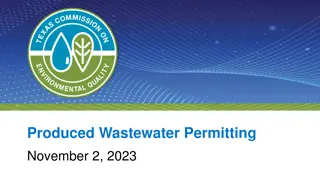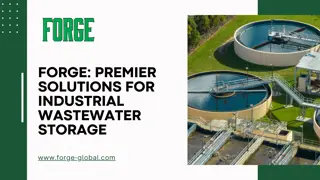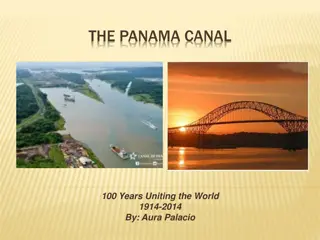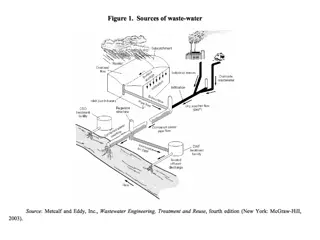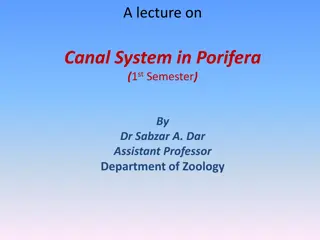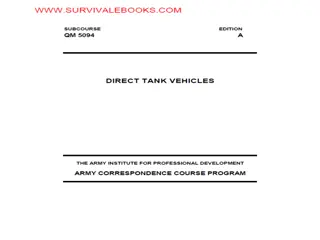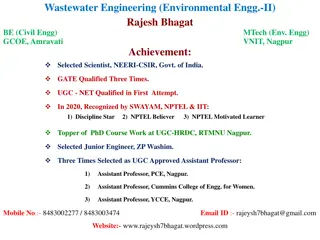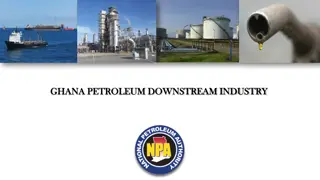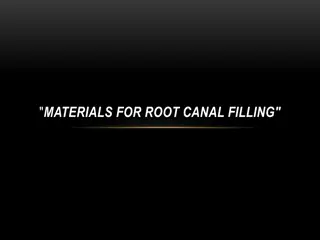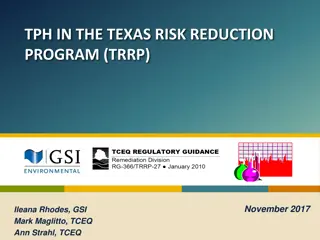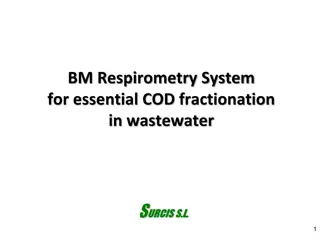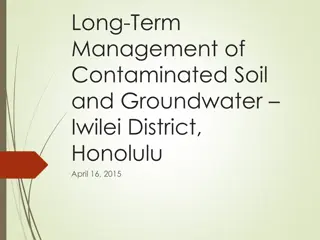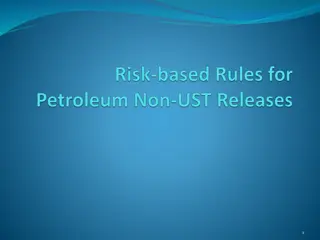Evaluation of Petroleum Hydrocarbon Degraders in Wastewater Canal Supplemented with Organic Carbon Source
This study explores the potential of native bacterial populations in wastewater for bioremediation of petroleum hydrocarbon-polluted environments. The research involved exposing Bonny light crude oil to wastewater canal samples supplemented with dry maize cob as an organic carbon source. Results showed the mineralization of petroleum hydrocarbons by various bacterial species, highlighting the efficacy of native bacterial consortia for environmentally friendly bioremediation practices.
Download Presentation

Please find below an Image/Link to download the presentation.
The content on the website is provided AS IS for your information and personal use only. It may not be sold, licensed, or shared on other websites without obtaining consent from the author. Download presentation by click this link. If you encounter any issues during the download, it is possible that the publisher has removed the file from their server.
E N D
Presentation Transcript
Petroleum hydrocarbon degraders from wastewater canal supplemented Petroleum hydrocarbon degraders from wastewater canal supplemented with dry maize cob as organic carbon source with dry maize cob as organic carbon source BY BY Olusola OlusolaAbayomi Abayomi Ojo Ojo- -Omoniyi Omoniyi, Ruth , Ruth Onyekachukwu OnyekachukwuAtewe Onitolo Onitolo Department of Microbiology, Faculty of Science Department of Microbiology, Faculty of Science Lagos State University, Lagos Lagos State University, Lagos Badagry Department of Biological sciences, Covenant University, Ota, Department of Biological sciences, Covenant University, Ota, Ogun State. Ogun State. A presentation at the 5th Faculty of Science Conference, Lagos State University, Ojo. Cutting edge scientific researches: A gateway to National Development 10th 10th- -14th October, 2017. 14th October, 2017. E-mail: solayom@yahoo.com Olusola.ojo-omoniyi@lasu.edu.ng Mobile phone: 234 Mobile phone: 234- -8055055478 Author for correspondence Sabbatical Appointment Sabbatical Appointment Atewe and and Abdulgafar Abdulgafar Oladipupo Oladipupo Badagry expressway, Lagos expressway, Lagos. 8055055478
ABSTRACT ABSTRACT Petroleum is a complex mixture composed primarily of aliphatics, alicyclics and aromatic hydrocarbons. This study was to evaluate the potentials of native bacterial population of wastewater environment with the ability for bioremediation of petroleum hydrocarbon polluted natural environment. A fresh water ecosystem west of Lagos state university, Ojo campus that has the history of being fed with both domestic wastewater and spent diesel oil served as source of bacterial samples. Serial dilution technique and total heterotrophic bacterial count for the wastewater was evaluated. The Bonny light crude oil was exposed to the wastewater canal through sterile oil- impregnated filter discs (Type HA 0.45 m diameter) supplemented with dried maize cob housed in perforated plastic balls for 30 days. The physicochemical properties of the freshwater habitat was determined prior to the introduction of oil-impregnated filter discs.
Thereafter, residual petroleum hydrocarbons were subjected to Gas chromatography to determine the degree of mineralization of the Bonny light crude. The gas chromatographic profile of the residual crude oil gave the convincing evidence of mineralization of petroleum hydrocarbons by native bacterial population. The petroleum hydrocarbon utilizers were; Bacillus brevis, Pseudomonas sp., Bacillus pumilus, Micrococcus luteus and Corynebacterium sp. The use of native bacterial consortium with petroleum hydrocarbon utilizing capabilities as well as being subjected to biostimulation techniques could prove to be a more environment - friendly approach to bioremediation of oil-polluted environment as well as enhance the processes of sustainable development rather than the use of exotic bacterial species. There were some fungal species isolated and characterized which includes; Aspergillus sp., Penicillium sp., and Fusarium sp. KEYWORDS: Biodegradation; Microorganisms; Organic carbon; petroleum hydrocarbon; wastewater
INTRODUCTION INTRODUCTION Crude oil constitutes a major source of pollution in our environment (FAQ, 2011). Petroleum is at present Nigeria s and indeed the world s most important derived energy source (Moffat and Linden, 2005). Available data show that oil and gas companies operating in Nigeria burn over $3.5 to $5billion yearly from the over 257 flow stations in the Niger Delta. Specifically the country flared about 17.15 percent of the 95.471 metric tonnes of gas produced in June, 2015 alone, according to data from Nigerian National Petroleum Corporation (NNPC) (Anonymous, 2015). Bioremediation is considered one of the most sustainable clean-up techniques but the potential has not been fully exploited in the field due to the fact that it is considered to be too slow to meet the immediate demands of the environment (Macaulay and Rees, 2014).
INTRODUCTION INTRODUCTION The parameters typically measured in laboratory tests of bioremediation efficacy include enumeration of microbial populations (Kastner et al., 1994; Peressutti et al., 2003), determination or fate of hydrocarbon degradation (disappearance of individual hydrocarbons and/or total hydrocarbons (Okoro, 2008). However, the most direct measure of bioremediation efficacy is the monitoring of hydrocarbon disappearance rates (Song and Bartha, 1990). Generally, type and identity of fresh or biodegraded oils and petroleum products can be readily revealed by their GC- FID traces especially where the biodegradation of spilled oil or petroleum product is heavy and background hydrocarbon levels are low in an impacted environment. In addition to measuring TPH (Total Petroleum Hydrocarbons) in samples, GC-FID chromatograms provide a distribution pattern of petroleum hydrocarbons (such as carbon range and profile of UCM (unresolved complex mixture), fingerprints of the major oil components (such as individual resolved n-alkanes and major isoprenoids), and information on the biodegradation extent of the spilled oil.
MATERIALS AND METHODS MATERIALS AND METHODS History of sampling site Wastewater sample were collected from wastewater canal at the west of Lagos State University (LASU), Ojo campus. The canal has the history of being fed with domestic wastewater from LASU staff quarters and from occasional discharge of diesel oil arising from a nearby generating house.
Determination of physicochemical parameters of wastewater samples Source of crude oil samples Bonny light Nigerian crude oil was obtained from WalterSmith Petroman Oil Limited, Lagos. Media preparation Potato dextrose agar Nutrient agar Minimal salt medium All media preparation was done following aseptic procedures. The media were sterilized in an autoclave at 15 Ib for 15 minutes at 121oC.
OIL EXPOSURE TO THE ENVIRONMENT Microcosm experiment for the in-situ determination of oil degradation rates were carried out (Gilbert and Higgins, 1978; Amund and Igiri, 1990). Maize cobs (Zea mays) were dried in the hot - air oven for 72 hours at 70 C. Thereafter, the dried maize cob was ground and 0.5g of this was placed on sterile filter paper discs (Type HA, 0.45 m) cob, then 2ml of Bonny light crude was evenly absorbed by the ground maize cob and the filter disc. Thereafter, it was inserted into perforated plastic balls through a slit to form an equatorial diaphragm. The balls were re-sealed and then placed in a perforated plastic container with a flat stone for it to be submerged as well as get the container attached to a pole with a line.
. This was kept in the canal for 30 days with daily monitoring. The Control were then set up in the laboratory by immersing the plastic balls that is housing the sterile oil filter into a sterile wastewater in order to determine the effect of biological phenomena on oil leaching. The balls were in four replicates and the filter discs were withdrawn aseptically from the canal at a 10-day intervals within the 30 day period. Each of the filters were later placed in 10ml of sterile wastewater in a screw cap bottles. These bottles were shaken at 200-oscillation /minute with a shaker for three hours in order to free the microorganisms from the filter paper.
ENUMERATION OF MICROORGANISMS . (Okerentugba and Ezeronye, 2003; Thamer et al., 2013) TOTAL HYDROCARBON UTILIZING MICROORGANISMS. Petroleum-hydrocarbon degraders were isolated and identified by the Bergey s Manual of Determinative Bacteriology (Buchanan and Gibbons, 1974). MICROMORPHOLOGICAL AND BIOCHEMICAL CHARACTERIZATION
BIOCHEMICAL TESTS CATALASE OXIDASE STARCH HYDROLYSIS INDOLE MOTILITY TEST GRAM STAIN (Gerhardt et al., 1981; Alexander and Strete, 2001).
Evaluation of Residual Total Petroleum Hydrocarbon (TPH) Residual petroleum was quantified using gas chromatographic analysis. (Adebusoye et al., 2007).
RESULTS RESULTS TABLE 1: DETERMINATION OF PHYSICOCHEMICAL PARAMETERS OF THE WASTEWATER SAMPLES Parameters pH Conductivity (uS/cm) Total dissolved solid (ppm) Turbidity (NTU) Salinity as C1-(ppm) Nitrate (mg/1) Ammonia (NH4-N) (mg/1) Phosphate (HPO43) (mg/1) Temperature (0C) Sample A 5.88 159.8 112.5 37 80.2 0 0.55 Sample B 5.87 159.4 112.7 30.5 80.1 0 0.58 0.21 0.24 26 27 Key: A Morning B Evening
TABLE 2: BACTERIAL GROWTH FROM SUSPENDED FILTER DISCS ON MEDIA. CONTROL SAMPLE PD A MS M NA MSM NA PDA DAY 101 101 101 105 104 103 0 0 0 0 8 5 4 10 5 4 3 20 2 3 2 30 1 3 2 2 3 1 KEY: NA: PDA: MSM: Minimal salt medium Nutrient agar Potato dextrose agar
TABLE 3: IDENTIFICATION OF HYDROCARBON - UTILIZING BACTERIA Probable orpholog Catalase reaction Motility Oxidase Microm Isolates organis Gram Indole Starch ms y smooth cream, circular colonies A Negative rods + - - - - Bacillus pumilus smooth, flat, rhizoidal, opaque and light cream Corynebacterium species G Positive rods + - - - - smooth cream, circular colonies J Negative rods + + - - + Pseudomonas species yellow, opaque circular colonies M Positive cocci + + - - - Micrococcus luteus cream, opaque circular colonies P Positive rods + - - - + Bacillus brevis KEY + = Positive - = Negative
FIG.1: TIME DEGRADATION COURSE OF RESIDUAL BONNYLIGHT CRUDE OIL 30-DAY PERIOD
FIG. 2: TIME DEGRADATION COURSE FOR THE CONTROL IN THE LABORATORY OVER 30-DAY PERIOD
FIG.3: GC PROFILE OF BONNYLIGHT CRUDE OIL AT DAY 0 (Microcosm)
FIG. 4: GC PROFILE OF BONNYLIGHT CRUDE OIL CONTROL (LABORATORY) DAY 0
FIG. 5: GC PROFILE OF RESIDUAL BONNYLIGHT CRUDE OIL CONTROL DAY 30
FIG. 6: GC PROFILE OF RESIDUAL BONNY LIGHT CRUDE OIL MICROCROSOM DAY 30
DISCUSSION DISCUSSION The physicochemical parameters of the fresh water habitat principally determined the type and populations of petroleum hydrocarbon utilizers found in the habitat The biodegradability of crude oil components varies from different types of environment, microorganisms and crude oil. The Bonny light crude oil was biodegraded into its intermediates with the saturated hydrocarbon fractions disappearing faster than others (FIG.4, 5 and 6). This corroborated the reports of Sugiura et al. (1996).
The microorganisms identified and characterized were in agreement with the findings of previous reearchers, however, the Corynebacterium sp. isolated displayed novelty trait in that some of its biochemical properties were different from those previously isolated. It may form subject of future research. The comparative analysis of the gas chromatographic profiles suggested significant reduction in quantity of certain petroleum hydrocarbon components as depicted by the peaks. This technology thus confirms the occurrence of biodegradation as reported by Thamer et al. 2013.
CONCLUSION CONCLUSION The detection of both bacterial and fungal population as mixed culture from the microcosm study revealed that no single organism has the metabolic capability to mineralize the complex petroleum hydrocarbons but a consortium. Gas chromatographic results thus provide both scientific and quantitative evidence that native microbial consortium could be a cost-effective and environment-friendly means of actualizing a clean-up process for petroleum hydrocarbon- polluted natural environment.
SELECTED REFERENCES SELECTED REFERENCES 1) Abioye, O. P., Agamuthu, P. and AbdulAziz, A. R. (2012). Biodegradation of used motor oil in soil using organic waste amendments. Biotechnology Research International 2012: 8p. (2) Adebusoye, S. A., Ilori, M. O., Amund, O. O., Teniola, O. D. and Olatope, S. O. (2007). Microbial degradation of petroleum hydrocarbons in a polluted tropical stream, World Journal of Microbiology and Biotechnology, 23(8): 1149 1159. (3) Alexander, S.D. and Strete, D. (2001). Microbiology: A photographic atlas for the laboratory. Benjamin cumming, an imprint of Addison Wesley Longman. Inc. Pp.69-92. (4) Amund O.O., and Igiri C.U. (1990). Biodegradation of Petroleum Hydrocarbons under tropical estuarine conditions. World Journal of Microbiology& Biotechnology 6:225-262. (5) Anonymous (2015). Nigeria burns off $5 billion resources yearly from gas flaring In: Nigerian National Petroleum Corporation (NNPC) Statistical Report June, 2015. Publ. THE GUARDIAN (www.ngguardiannews.com) Nov. 6th2015. Pp. 25 29.
(6) Das, N. and Chandran, P. (2011). Microbial degradation of petroleum hydrocarbon Contaminants: An overview. Biotechnology Research International 2011(2011): 13p. Article ID: 941810. (7) FAQ (2011). Microbes & oil spills. American Academy of Microbiology, Washington DC, 20036. www.asm.org . (8) Gerhardt, P., Murray, R.G E., Costilow, R.N., Nester, E. W., Wood, W. A., Krieg, N. R. and Phillips, G. B. (1981). Manual of methods for general bacteriology. American Society for Microbiology Washington, DC 20006. Pp. 409 425. (9) Gilbert, P.C., Higgins, I. J. (1978). The microbial degradation of crude mineral oils at sea. Journal of General Microbiology 108:63-70. (10) Holliger, C., Gaspard, S., Glod, G., Heijman, C., Schumacher, W., Schwarzenbach, R.P., and Vasquez, F. (1997). Contaminated environment in the subsurface and bioremediation: Organic contaminants. FEMS Microbiology Reviews 20 (3-4): 517- 523.


